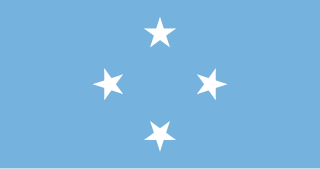
The Federated States of Micronesia, or simply Micronesia, is an island country in Micronesia, a subregion of Oceania. The federation consists of four states—from west to east, Yap, Chuuk, Pohnpei and Kosrae—that are spread across the western Pacific. Together, the states comprise around 607 islands that cover a longitudinal distance of almost 2,700 km (1,700 mi) just north of the equator. They lie northeast of Indonesia and Papua New Guinea, south of Guam and the Marianas, west of Nauru and the Marshall Islands, east of Palau and the Philippines, about 2,900 km (1,800 mi) north of eastern Australia, 3,400 km (2,100 mi) southeast of Japan, and some 4,000 km (2,485 mi) southwest of the main islands of the Hawaiian Islands.

Geography of the Federated States of Micronesia (FSM), a country located in the western Pacific Ocean, and in the Micronesia cultural and ecological sub-region of Oceania. While its total land area is very small at 702 km2 (271 sq mi), it has the 14th largest exclusive economic zone at 2,996,419 km2 (1,156,924 sq mi).

Demographic features of the population of the Federated States of Micronesia include population density, ethnicity, education level, health of the populace, economic status, religious affiliations and other aspects. The indigenous population of the Federated States of Micronesia, which is predominantly Micronesian, consists of various ethnolinguistic groups. English has become the common language. Population growth remains high at more than 3%, but is ameliorated somewhat by net emigration.

Micronesia is a subregion of Oceania, consisting of about 2,000 small islands in the Northwestern Pacific Ocean. It has a close shared cultural history with three other island regions: Maritime Southeast Asia to the west, Polynesia to the east, and Melanesia to the south—as well as with the wider community of Austronesian peoples.

Inbreeding is the production of offspring from the mating or breeding of individuals or organisms that are closely related genetically. By analogy, the term is used in human reproduction, but more commonly refers to the genetic disorders and other consequences that may arise from expression of deleterious recessive traits resulting from incestuous sexual relationships and consanguinity. Animals avoid inbreeding only rarely.
Genetic drift, also known as random genetic drift, allelic drift or the Wright effect, is the change in the frequency of an existing gene variant (allele) in a population due to random chance.
Achromatopsia, also known as Rod monochromacy, is a medical syndrome that exhibits symptoms relating to five conditions, most notably monochromacy. Historically, the name referred to monochromacy in general, but now typically refers only to an autosomal recessive congenital color vision condition. The term is also used to describe cerebral achromatopsia, though monochromacy is usually the only common symptom. The conditions include: monochromatic color blindness, poor visual acuity, and day-blindness. The syndrome is also present in an incomplete form that exhibits milder symptoms, including residual color vision. Achromatopsia is estimated to affect 1 in 30,000 live births worldwide.

In population genetics, the founder effect is the loss of genetic variation that occurs when a new population is established by a very small number of individuals from a larger population. It was first fully outlined by Ernst Mayr in 1942, using existing theoretical work by those such as Sewall Wright. As a result of the loss of genetic variation, the new population may be distinctively different, both genotypically and phenotypically, from the parent population from which it is derived. In extreme cases, the founder effect is thought to lead to the speciation and subsequent evolution of new species.

Monochromacy is the ability of organisms to perceive only light intensity without respect to spectral composition. Organisms with monochromacy lack color vision and can only see in shades of grey ranging from black to white. Organisms with monochromacy are called monochromats. Many mammals, such as cetaceans, the owl monkey and the Australian sea lion are monochromats. In humans, monochromacy is one among several other symptoms of severe inherited or acquired diseases, including achromatopsia or blue cone monochromacy, together affecting about 1 in 30,000 people.

Kapingamarangi is an atoll and a municipality in the state of Pohnpei of the Federated States of Micronesia. It is by far the most southerly atoll or island of the country and the Caroline Islands, 300 km (190 mi) south of the next southerly atoll, Nukuoro, and 740 km (460 mi) southwest of the main island of Pohnpei state; it forms a Polynesian outlier.

Nukuoro is an atoll in the Federated States of Micronesia. It is a municipality of the state of Pohnpei, Federated States of Micronesia. It is the secondmost southern atoll of the country, after Kapingamarangi. They both are Polynesian outliers. As of 2007, Nukuoro had a population of 372, though several hundred Nukuorans live on Pohnpei. Fishing, animal husbandry, and agriculture are the main occupations. A recent project to farm black pearl oysters has been successful at generating additional income for the island's people.
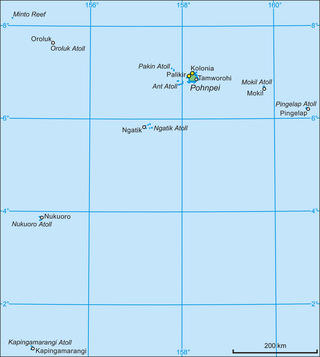
Pohnpei State is one of the four states of the Federated States of Micronesia (FSM). The other states are, from east to west, Kosrae State, Chuuk State, and Yap State. The state's main island is Pohnpei.
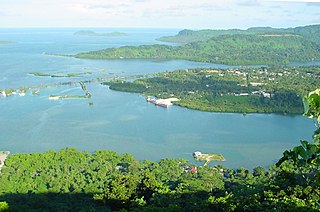
Kolonia is a coastal town and the capital of Pohnpei State in the Federated States of Micronesia (FSM). It's not to be confused with the far smaller Colonia, the capital of the State of Yap. It was also the former FSM capital before being replaced by Palikir in 1989, located nearby to the southwest in the municipality of Sokehs. It has 6,074 people.
The Pingelapese language is a Micronesian language native to Pingelap, an atoll belonging to the state of Pohnpei in the Federated States of Micronesia. This atoll is the homeland to the Pingelapese people, consisting of a three-square mile range of uninhabited small coral islets, Daekae and Sukora, and the inhabited islet, Pingelap. These islands partially make up the Caroline Islands.
Mokilese, also known as Mwoakilloan, Mwokilese, or Mwoakilese, is a Micronesian language originally spoken on Mwoakilloa, Federated States of Micronesia. Of the 1200 Mokilese speakers, only about 500 live on Mwoakilloa.

Oroluk was one of the administrative divisions of Pohnpei State, Federated States of Micronesia. In 1985, it became part of Sokehs Municipality.
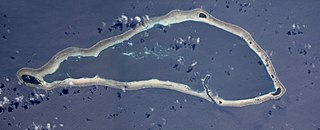
Sapwuahfik, formerly Ngatik, or the Raven Islands is a 110-square-kilometer (42 sq mi) atoll in Pohnpei state of the Federated States of Micronesia. It is a village and municipality of roughly 430 people on a land area of 1.5 square kilometers (0.58 sq mi).
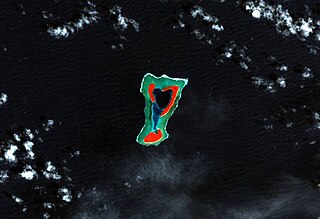
Mwoakilloa (or Mokil previously named Wellington Island or Duperrey Island, after Louis Isidore Duperrey) is an inhabited atoll in the central Pacific Ocean. Geographically, it belongs to the Caroline Islands and is a municipality of the outlying islands of Pohnpei State of the Federated States of Micronesia.
Sugar Cane, was a three-decker merchantman and convict ship. In 1793 she transported convicts from Ireland to Australia. On her return trip she sailed from Bengal to Britain under contract to the British East India Company. During the French Revolutionary Wars she sailed under a letter of marque as a slave ship. She made two voyages carrying enslaved people from West Africa to the Americas. In 1796 or 1797, on her second slave trading voyage she captured a French ship, but shortly thereafter was herself captured. The British Royal Navy recaptured her and she apparently was returned to service. She is last listed in 1798.

The Human Rights Measurement Initiative finds that the Federated States of Micronesia are fulfilling 94.9% of what it should be fulfilling for the right to health based on its level of income. When looking at the right to health with respect to children, the Federated States of Micronesia achieve 97.1% of what is expected based on their current income. In regards to the right to health amongst the adult population, the country achieves only 91.9% of what is expected based on the nation's level of income. The Federated States of Micronesia fall into the "good" category when evaluating the right to reproductive health because the nation is fulfilling only 95.8% of what the nation is expected to achieve based on the resources (income) it has available.

















